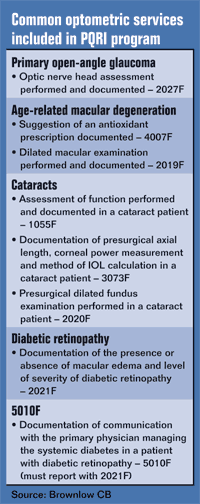Consider participation in CMS program for quality assessment
|
|
Health care costs continue to skyrocket, with Medicare and Medicaid suffering mightily as the world’s largest purchasers of health care. The health of the public continues to suffer, as the United States still has created no organized system for helping people know what care they truly need, what preventive measures they should be taking, how they should be eating and exercising to maintain their health, the best places to receive their care and the expected cost for the care they must receive.
As consumers of medical care, we have no clue whether the care we get is of sufficient quality or whether the fees are fair. We rely on old, but not proven to be accurate, methods of deciding which doctors to use, including word of mouth, Yellow Pages and proximity. There must be a better way.
CMS quality initiative
The government, in this case the U.S. Centers for Medicare and Medicaid Services (CMS), is starting a program to attempt to quantify quality for a subset of medical services. Several eye care services are included, and four of those are services commonly provided by doctors of optometry.
 |
American Optometric Association (AOA) members may learn more about this program at the AOA Web site in a section called, “Pay for performance – quality reporting” (www.aoa.org/x7506.xml). The section is set up well, permitting users to go as deeply into the details as they wish, with links to additional reference material on the CMS Web site (www.cms.hhs.gov/PQRI/Downloads/PQRIMeasuresList.pdf) and elsewhere.
Participation is voluntary
Participation in the program, the Physician Quality Reporting Initiative (PQRI), is voluntary. Your reward for participating is cash, with CMS writing you a check for the bonus incentive payment once you complete the program. This payment will be 1.5% of the total allowed charges for covered Medicare physician fee schedule services provided July 1 to Dec. 31, 2007.
The payment will be made to all doctors who provide care to patients for any of the listed conditions and, using new level II CPT codes created for the purpose, report on at least three of the included measures for at least 80% of the times the measure is reportable.
Coding for POAG
For example, if a doctor is managing a patient’s primary open-angle glaucoma (POAG) and completes an optic nerve evaluation, the required measurefor POAG, the doctor would indicate this when filling out the CMS claim form for the visit. The office visit and procedure codes would be reported as usual on the CMS 1500, with the appropriate diagnosis code for the POAG. The code for POAG optic nerve head assessment performed and documented is 2027F. That code would appear as a CPT code on the next line of the CMS 1500, again with the diagnosis code for POAG.
If a doctor is seeing a patient with POAG and decides to not do the optic nerve head assessment at that visit, the doctor is able to report that decision on the CMS 1500 by using a modifier. As before, the office visit and other procedures would be entered on the CMS 1500 with the proper diagnosis codes. The code for the optic nerve head assessment would be entered on a separate line, accompanied by the modifier that most closely explains the reason the doctor chose to not do the measure.
Three modifiers can be used:
- 1P indicates a medical reason for not performing the nerve head assessment. Perhaps it had already been done at an earlier visit and was not necessary at this visit or the patient had suffered an adverse drug reaction last time it was done.
- 2P indicates reasons related to the patient. For example, the patient has refused the procedure for personal, economic, social or religious reasons.
- 3P indicates that the doctor did not have the resources available to complete the procedure, insurance coverage limits the frequency of the measure or something else about the health care system that precludes the doctor from doing the test.
The modifiers are important, indicating that this visit should not be counted against the 80% compliance numbers for earning the bonus.
Consider participation
My recommendation regarding the PQRI program is that most ODs should strongly consider participating. There will be very little additional paper work. There is no application process for the program; you just decide whether or not to use the level II CPT codes. If you use them, Medicare will begin collecting data. If you do not use them, they will not. No extra record keeping is required either, as any audit that Medicare would conduct to ensure compliance would be of your medical records, just like their audits are if you are not participating in the PQRI program.
You have something to gain: The 1.5% of all your Medicare-allowed amounts for 6 months. The bonus is not limited to payments related to the covered conditions. You have nothing to lose: You are already providing care for the listed conditions to Medicare patients, you are keeping good medical records and submitting CMS 1500 forms.
For more information:
- Charles B. Brownlow, OD, FAAO, can be reached at PMI, LLC, 321 W. Fulton St., PO Box 608, Waupaca, WI 54981; (715) 942-0410; fax: (715) 942-0412; e-mail: Brownlowod@aol.com.

